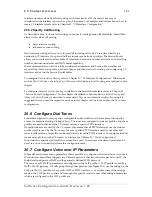
186
CS Context Overview
•
We synchronize the time of the SmartNode to the ISDN time. (Refer to section 'Configure
General Settings'). To get useful system event logs it is very recommended to set the system
time!
•
We need four ISDN ports, two for the PSTN and another two for the PBX. (Refer to section
'Configure ISDN Ports')
•
Furthermore we need two PSTN interfaces. On each we bind two ISDN ports, which means,
that we create a line hunt group on every PSTN interface. (Refer to section 'Configure Call
Routing')
•
For every remote H.323 device we need a H.323 interface. There are two in total. One gets the
remote IP address of the SmartNode in office A, the other the IP address of the SmartNode in
office B. (Refer to section 'Configure Call Routing')
•
We need a Session Router routing table to route the calls depending on the called party
number. (Refer to section 'Configure Call Routing')
•
We enable DTMF relay. (Refer to section 'Configure Voice over IP Settings')
•
We specify codec G.723, likewise we define H.323 'direct call signaling'. (Refer to section
'Configure a H.323 VoIP Connection')
Figure 20-5 illustrates the above mentioned CS configuration.
Figure 20-5: CS Configuration
Configure General CS Settings
First we set clock-source to ISDN port 2/3 and enable synchronize to ISDN time.
SN>
enable
SN#
configure
SN(cfg)#
system
SN(sys)#
clock-source 2 3
SN(sys)#
synchronize-to-isdn-time
Software Configuration Guide, Revision 1.03
















































